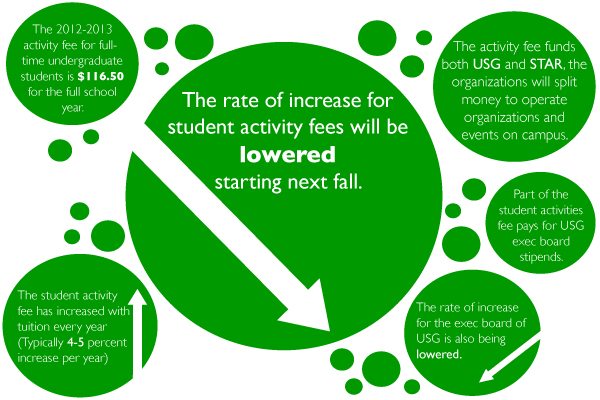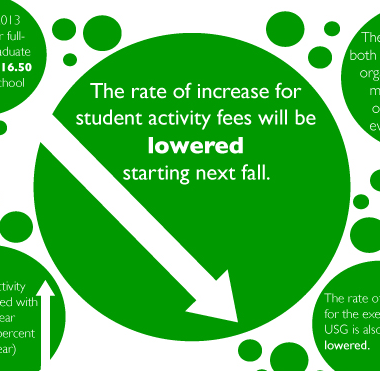
Students who find it hard to keep up with St. Thomas’ annual tuition increase may find some relief in the form of student activity fees next year.
Student activity fees, which are factored in to the total cost of tuition, typically increase with the rate of tuition every year. However, Undergraduate Student Government and STAR have proposed to decrease the rate of increase on the fee.
“(STAR and USG) put our funds to very good uses,” USG president Mike Orth said. “We give them back to the students, but we’ve found … we don’t need a 4-5 five percent increase in our budgets every single year because we don’t have more students on campus.”
Orth said the rate of increase on the fee would change to reflect the rate of inflation each year. USG would still have enough money to give to clubs, and allocations for clubs and conferences would not be decreased.
“In the past, we have given clubs allocation requests, and then they could choose to request contingency fees,” USG vice president Jenna Johnson said, “which is like more money if they needed more, and we have had a huge rollover.”
Johnson also said moving to the Anderson Student Center last year left USG with extra funds.
“Moving to the Anderson Student Center … we budgeted more money for clubs requesting more funds because of the new space. We didn’t know if we would be putting on more activities or whatnot, so we had a rollover from year to year,” Johnson said. “This year, we’ve been really lenient on giving clubs a lot of money.”
Senior Justin Rubin, president of St. Thomas’ Math Club, said he would not be concerned with any possible shortages as a result of the reduction.
“We had almost too much money this year,” Rubin said. “So honestly, I don’t think we would be affected.”
Orth said USG and STAR both hope that by reducing the rate of increase on the fee, students will be able to save a bit of money each year.
“We figure this will help students in the end, when they are paying tuition to the university,” Orth said. “Even if it’s not more than $100, it’s still something.”
Freshman Stuart Macgregor said he would be happier if the fee was just cut altogether, especially for students who aren’t involved in clubs.
“I think people just need to start paying for their own stuff,” Macgregor said. “I don’t see why someone should have to pay for clubs that they aren’t really in.”
Freshman McKaela Laxen said she does not think the extra savings will help when thinking about total tuition.
“With the amount of money we are already spending, what’s another $100?” Laxen said.
Rubin said he never really noticed the fee.
“It’s such a small fee in the first place,” Rubin said. “It never really concerned me.”
Johnson said she is confident USG would have enough money to fund clubs if the change is made, but she said the decision would have to be re-evaluated if funds became low.
“I’m not really concerned in the near future that we are going to have any kind of shortage of money, but if it does come to a point where we have a shortage, we’ll have to reevaluate the increase, and go from there,” Johnson said. “But for the next few years, we’re pretty confident that we won’t need that much more money from student activity fees.”
The council still has to vote on the decision, but Johnson said St. Thomas’ Chief Financial Officer, Mark Vangsgard, has been advising the proposal.
“He just said make sure you have enough money for the students, and go from there. So this is definitely something we will be considering next year and for the few years to come,” Johnson said. “For now, we think it’s a good decision.”
USG decreases rate of increase on executive position pay
USG has also decreased the rate of increase on the pay for its executive board. The executive board recently voted on the decision, which will be put in place next fall.
Orth said USG executive positions on campus are some of the only student jobs that have increased at a regular rate.
“Compared to other student positions on campus, they don’t increase every year at a fixed rate,” Orth said. “We’ve found that we want to keep our pay in line with other students at the university.”
USG’s constitution says that members of USG’s executive board are each paid a semesterly stipend of $1500 with an adjustment of 3 percent per year.
Johnson said much of the executive board did not know about the significant pay increase that was occurring every year.
“We were actually unaware, or I was at least, that (the pay) was increasing at such a rapid rate,” Johnson said. “When (Orth) brought it to our attention, we were like that’s not right.”
Orth said while USG executives don’t get paid a lot, they want to focus their funds on the students.
“That’s not to say that we get paid a lot. We certainly don’t,” Orth said. “We want to be fair to students in the way we use their money, because ultimately it’s their student activity fee that is going to USG and paying for our stipends.”
Johnson said the decrease should not be a deterring factor for future USG executives.
“If you’re on the E-board at USG, you shouldn’t be doing it for the pay anyway,” Johnson said. “You are doing it for the students, that’s why you are elected.”
Gabrielle Martinson can be reached at mart5649@stthomas.edu.


Ohhhh, the “rate” of increase is being lowered……that’s going to help students soooooooo much!
What the story title should actually say is “USG, STAR propose decrease in rate increase on student activity fees”, because nothing is being decreased in absolute terms here; students will still be paying more than this year.
I agree that the title is misleading. Also, since the entire fee is $116.50 for the 2012-2013 school year, the fee will not be changing by anything close to $100. Even if the price was not increased at all for next year, it would still only be a “savings” of about $5 (as compared to a 5% increase). However, I do appreciate USG’s efforts on the students’ behalf and would love to see other divisions of the University follow suit.